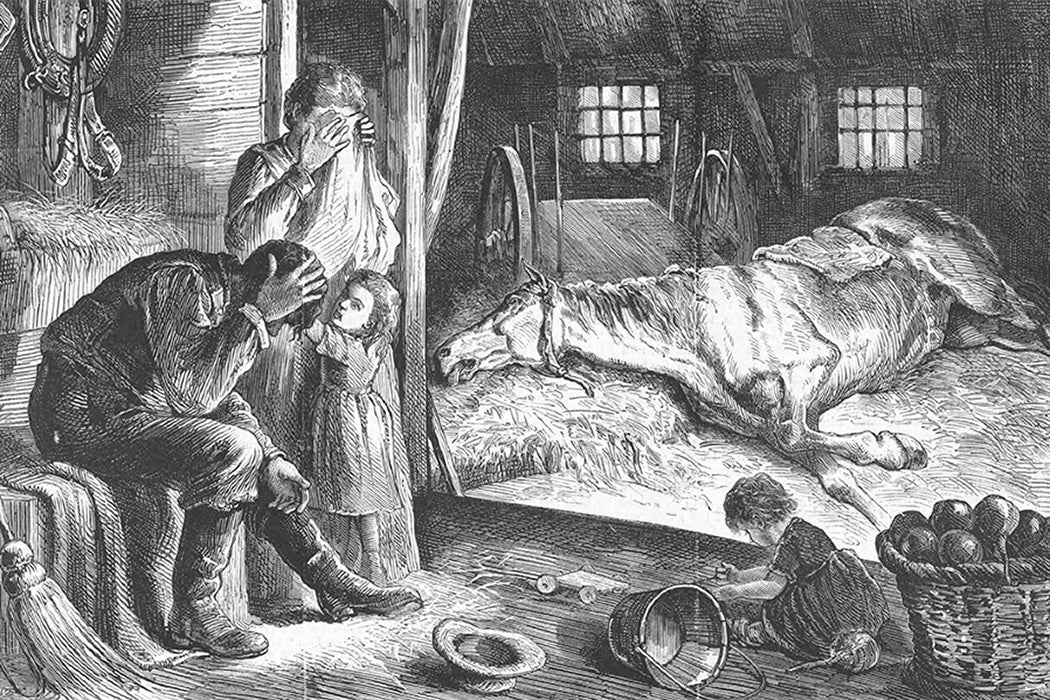In late 1872, North America west of the Mississippi unexpectedly lost its horsepower. Literally: the horses who hauled streetcars, fire engines, and all the local freight sickened with influenza. It was the age of steam, yes, but railroads and ships all depended on goods and passengers getting to and from them by horse-power—over what we would now call the “last mile” of delivery. As a result of this horse flu, cities slowed to a crawl. A human-powered crawl.
As James P. McClure explains, most horses didn’t die during the plague of equine influenza, but they were out of commission for the count, and cities scrambled to deliver people, food, fuel, everything.
An epidemic among (non-human) animals is an epizootic, and this one was called the Epizootic. It had other names, for everybody talked about it: “influenza, catarrh, catarrhal fever, or simply the horse disease, the distemper.”
Infectious diseases spreading in stables were not uncommon—McClure lists “spinal meningitis to pink eye to ‘eruptive fever’”—but this was a major outbreak. It started in Canada in October and spread south to Boston and New York, sweeping west to Chicago by the end of the month and down into Cincinnati, Norfolk, and Charleston in early November. It was similar to human flus, causing “a runny nose, coughing, sore throat, chills, fever, weakness.”
Mortality was as low as 1 percent and as high as 10 percent, depending on the location. But more died from opportunistic infections that followed the flu, and from being overworked when they were sick.
“A second wave of disease swept through the cities just as the influenza seemed to abate,” writes McClure. And it wasn’t just working-class horses: Cornelius Vanderbilt’s Mountain Boy, valued at $20,000 (half a million dollars today), died of pneumonia after getting over the flu.
To give a sense of the scale of horse-dependence: in New York City, with a human population closing in on a million in 1870, had as many as 14,000 horses employed by the stage and streetcar companies alone for hauling commuters. Oxen were experimented with, but they were incapable of working city streets. More typically, people ended up pulling streetcars, stages, drays, fire engines, and carts.
Some attributed the disease to “atmospheric conditions—something to do with ozone, or temperature, or electrical energy perhaps—or to poisonous gasses or microscopic dead matter in the air.” McClure notes that “veterinarians could not even agree that it was contagious.”
All sorts of treatments were tried, including bleeding and potent, not to say toxic, substances like belladonna and arsenic. The best cure? Rest and good care. As capitalist engines, however, plenty of horses didn’t get this. They were treated poorly and suffered as a result, the flu adding insult to injury.
“Carcasses in the streets of large cities demonstrated that many owners drove their horses hard after the onset of the disease,” writes McClure.
The American Society for the Prevention of Cruelty to Animals had the legal ability in New York to intervene in abuse of working horses, and they used it under the irrepressible leadership of Henry Bergh. Stage and streetcar owners tried to injunction him out of his reformatory business but failed.
As McClure notes, “in that dawn of an era of robber barons, kindness to animals was well and good, but interference with business operations” was another matter entirely. Owners treated horses like “inanimate property” said Bergh, and when the animals actually were inanimate, dead, there was no sense in flogging them any further.
Weekly Newsletter
Most worrisome to urbanites was the near collapse of fire department mobility. For instance, just two of NYC’s 144 fire horses escaped the Epizootic. In Boston, only three of the eighty fire horses didn’t catch the flu. Fire departments took good care of their horses, but the animals needed weeks to fully recover. When Boston started burning on November 9, it took a long time for the first fire engine to arrive—it was pulled by men, not horses. Sixty-four acres were reduced to rubble and ashes by the time the fire was put out on November 11.
“The tragedy could not be ascribed simply to a lack of horses,” writes McClure, but the horseless situation did not help.
After experiencing the paralysis of urban life brought on by the Epizootic, many thought that some kind of mechanical contrivance should replace horses on the street. What would it be?
Support JSTOR Daily! Join our membership program on Patreon today.







